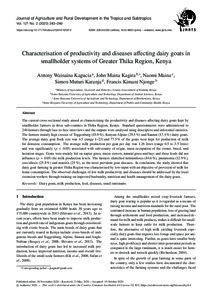Characterisation of productivity and diseases affecting dairy goats in smallholder systems of Greater Thika Region, Kenya
| dc.date.accessioned | 2020-11-26T15:56:22Z | |
| dc.date.available | 2020-11-26T15:56:22Z | |
| dc.date.issued | 2020-11-18 | |
| dc.identifier | doi:10.17170/kobra-202010191972 | |
| dc.identifier.uri | http://hdl.handle.net/123456789/12036 | |
| dc.language.iso | eng | eng |
| dc.rights | Namensnennung 4.0 International | * |
| dc.rights.uri | http://creativecommons.org/licenses/by/4.0/ | * |
| dc.subject | dairy goats | eng |
| dc.subject | milk production | eng |
| dc.subject | feed | eng |
| dc.subject | animal diseases | eng |
| dc.subject | small ruminants | eng |
| dc.subject.ddc | 630 | |
| dc.title | Characterisation of productivity and diseases affecting dairy goats in smallholder systems of Greater Thika Region, Kenya | eng |
| dc.type | Aufsatz | |
| dcterms.abstract | The current cross-sectional study aimed at characterising the productivity and diseases affecting dairy goats kept by smallholder farmers in three sub-counties in Thika Region, Kenya. Standard questionnaires were administered to 240 farmers through face-to-face interviews and the outputs were analysed using descriptive and inferential statistics. The farmers mainly kept crosses of Toggenburg (45.9 %), Kenyan Alpine (29.5 %) and Saanen (17.4 %) dairy goats. The average dairy goat flock size was 4.5 (range 1–23) and 77.5 % of the goats were kept for production of milk for domestic consumption. The average milk production per goat per day was 1.26 litres (range 0.5 to 3.5 litres) and was significantly (p < 0.05) associated with sub-county of origin, main occupation of the owner, breed, and lactation stages. Goats were mainly fed on napier grass, maize stovers, natural grass and hay; and these feeds did not influence (p > 0.05) the milk production levels. The farmers identified helminthosis (84.6 %), pneumonia (32.9 %), coccidiosis (25.8 %) and mastitis (25 %), as the most prevalent goat diseases. In conclusion, the study showed that dairy goat farming in greater Thika Region was characterised by low-input with an objective of provision of milk for home consumption. The observed challenges of low milk productivity and diseases should be addressed by the local extension workers through training on improved husbandry, nutrition and health management of the dairy goats. | eng |
| dcterms.accessRights | open access | |
| dcterms.creator | Wainaina Kagucia, Antony | |
| dcterms.creator | Kagira, John | |
| dcterms.creator | Maina, Naomi | |
| dcterms.creator | Muturi Karanja, Simon | |
| dcterms.creator | Njonge, Francis Kimani | |
| dc.subject.swd | Ziegenmilch | ger |
| dc.subject.swd | Milchproduktion | ger |
| dc.subject.swd | Futtermittel | ger |
| dc.subject.swd | Tierkrankheit | ger |
| dc.subject.swd | Wiederkäuer | ger |
| dc.subject.swd | Kleinbauer | ger |
| dc.subject.swd | Kenia | ger |
| dc.type.version | publishedVersion | |
| dcterms.source.identifier | EISSN 2363-6033 | |
| dcterms.source.issue | No. 2 | |
| dcterms.source.journal | Journal of Agriculture and Rural Development in the Tropics and Subtropics (JARTS) | eng |
| dcterms.source.pageinfo | 243-249 | |
| dcterms.source.volume | Vol. 121 | |
| kup.iskup | false |
Files in this item
This item appears in the following Collection(s)
-
Vol 121, No 2 (2020) [13]


